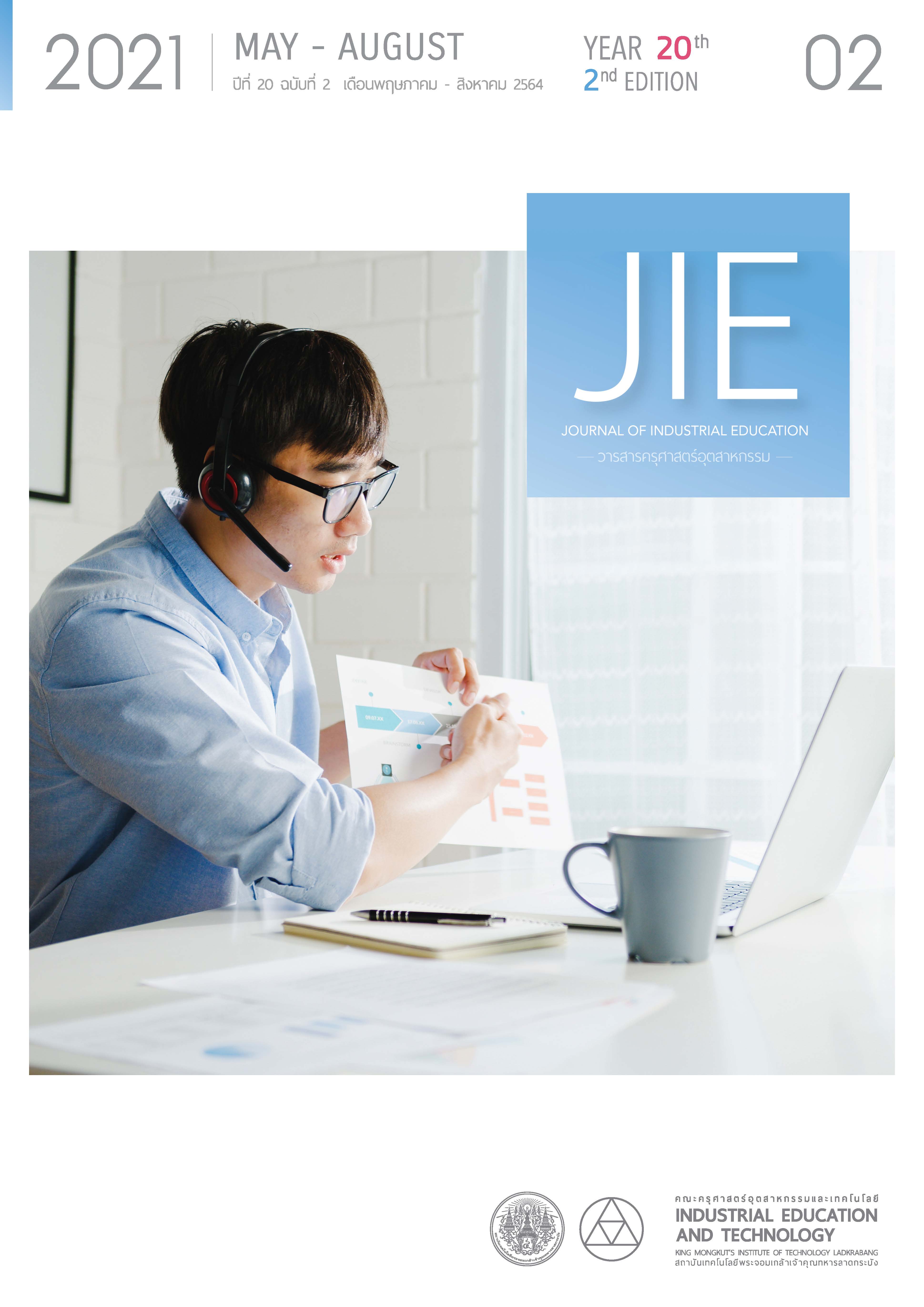การจัดการเรียนรู้โดยใช้ปัญหาเป็นฐานร่วมกับบทเรียนผ่านเครือข่ายอินเทอร์เน็ต เรื่อง การเชื่อมอะลูมิเนียม สำหรับนักศึกษาครุศาสตร์อุตสาหการ
คำสำคัญ:
การจัดการเรียนรู้โดยใช้ปัญหาเป็นฐาน, บทเรียนผ่านเครือข่ายอินเทอร์เน็ต, แผนการจัดการเรียนรู้, การเชื่อมอะลูมิเนียมบทคัดย่อ
งานวิจัยนี้มีวัตถุประสงค์เพื่อพัฒนาแผนการจัดการเรียนรู้ด้วยการเรียนโดยใช้ปัญหาเป็นฐานร่วมกับบทเรียนผ่านเครือข่ายอินเทอร์เน็ต เรื่องการเชื่อมอะลูมิเนียม เพื่อพัฒนาความสามารถการคิดวิเคราะห์ สำหรับนักศึกษาครุศาสตร์อุตสาหการ กลุ่มตัวอย่างในการวิจัยได้แก่นักศึกษาภาควิชาครุศาสตร์อุตสาหการ ชั้นปีที่ 3 จากการสุ่มตัวอย่างแบบกลุ่ม จำนวน 60 คน แบ่งเป็น 3 กลุ่ม ได้แก่ กลุ่มที่ 1 กลุ่มหาประสิทธิภาพบทเรียนผ่านเครือข่ายอินเทอร์เน็ต จำนวน 20 คน กลุ่มที่ 2 กลุ่มทดลองเรียนที่เรียนรู้โดยใช้ปัญหาเป็นฐานร่วมกับบทเรียนผ่านเครือข่ายอินเทอร์เน็ต จำนวน 20 คน และกลุ่มที่ 3 กลุ่มเรียนด้วยการจัดการเรียนรู้แบบปกติ จำนวน 20 คน เครื่องมือที่ใช้ในการวิจัยได้แก่ แผนการจัดการเรียนรู้แบบการใช้ปัญหาเป็นฐาน แบบประเมินคุณภาพแผนการจัดการเรียนรู้ บทเรียนผ่านเครือข่ายอินเทอร์เน็ต เรื่อง การเชื่อมอะลูมิเนียม แบบประเมินคุณภาพบทเรียนผ่านเครือข่ายอินเทอร์เน็ต และแบบประเมินผลสัมฤทธิ์ทางการเรียนของนักศึกษาที่เรียนด้วยบทเรียนผ่านเครือข่ายอินเทอร์เน็ต จากนั้นนำผลการทดลองมาวิเคราะห์ ค่าเฉลี่ย () ส่วนเบี่ยงเบนมาตรฐาน (S.D.) และทดสอบ t-test ผลการวิจัยพบว่าคุณภาพแผนการจัดการเรียนรู้โดยใช้ปัญหาเป็นฐาน ร่วมกับบทเรียนผ่านเครือข่ายอินเทอร์เน็ตอยู่ในระดับดี (
= 4.25, S.D. = 0.38) และคุณภาพบทเรียนผ่านเครือข่ายอินเทอร์เน็ตอยู่ในระดับดีมาก (
= 4.67, S.D. = 0.30) ผลการหาประสิทธิภาพบทเรียนผ่านเครือข่ายอินเทอร์เน็ต มีอัตราส่วนระหว่างประสิทธิภาพของกระบวนการต่อประสิทธิภาพของผลลัพธ์ (E1/E2) เท่ากับ 81.43/82.33 ซึ่งสูงกว่าเกณฑ์ที่ตั้งไว้คือ 80/80 ผลการเปรียบเทียบผลสัมฤทธิ์ทางการเรียนระหว่างผู้เรียนด้วยแผนการจัดการเรียนรู้โดยใช้ปัญหาเป็นฐาน ร่วมกับบทเรียนผ่านเครือข่ายอินเทอร์เน็ต และผู้เรียนที่เรียนด้วยการจัดการเรียนรู้แบบปกติแตกต่างกันอย่างมีนัยสําคัญทางสถิติที่ .05
เอกสารอ้างอิง
Chumman, N., Sukwan, O., Chareonsri, P., & Kumsucharit, S. (2020). “Industrial education and student competency enhancement.” Journal of Industrial Education. 14(2), 60-74. (in Thai)
Sirinupong, P. (2020). “Introduction to industrial systems for higher education students in teaching curriculum.” Journal of Industrial Education. 14(2), 134-147. (in Thai)
Alrahlah, A. (2016). “How effective the problem-based learning (PBL) in dental education: A critical review.” Saudi Dental Journal. 28, 155–161.
Dittapanya, P., & Haemaprasith, S. (2020). “Effect of problem base learning with think pair share technique to develop scientific problem solving ability and self-confidence of fifth grade students.” Journal of Industrial Education. 14(2), 24-41. (in Thai)
Muangseengarm, O., Tuntiwongwanich, S., & Kiddee, K. (2020). “Development of analytical thinking by problem-base learning with e-learning on two-dimensional array for vocational certificate students” Journal of Industrial Education. 19(3), 11-20. (in Thai)
Tapiantong, S., Kantathanawat, T., & Innoi, S. (2020). “The learning management with google application for education collaboration networking lessons to promote learning achievement in related skills on the information technology in presentation method for grade 9.” Journal of Industrial Education. 19(1), 15-24. (in Thai)
Boonprasom, C., & Sinthanakul, K. (2020). “The development of WBI for blended learning according to competency based by using MIAP learning method on data structure and algorithm.” Technical Education Journal. 11(1), 12-20. (in Thai)
Pitiwong, A., Tuntiwongwanich, S., & Kiddee, K. (2020). “The development of programming skills with problem-based learning method together with e-learning courseware on selection structure programming for grade 7 students.” Journal of Industrial Education. 19(2), 20-30. (in Thai)
Polsawat, A., & Chansiriwat, T. (2016). “The development of learning model for student by using problem-based learning for teaching practical skills course in programmable logic controller technology.” Journal of Humanities and Social Sciences Valaya Alongkorn. 12(1), 61-72. (in Thai)
Sumalai, K., Supavarasuwat, P., & Maunsaiyat, S. (2019). “An e-learning lesson on basic indoor electricity for level 1 indoor electricians.” Journal of Industrial Education. 18(2), 188-196. (in Thai)
Boosamsai, S., Oungthong, M., & Mangkhalakun, C. (2020). “Development of computer assisted instruction on charting and calculating shear force and bending moment diagrams for students in faculty of thechnical education in king mongkut’s university of technology north Bangkok.” Journal of Industrial Education. 19(1), 75-83. (in Thai)
Kassymova, G., Akhmetova, A., Baibekova, M., Kalniyazova, A., Mazhinov, B., & Mussina S. (2020). “E-Learning Environments and Problem-Based Learning International.” Journal of Advanced Science and Technology. 29(7), 346-356.
Nurkhin, A., Kardoyo, K., Pramusinto, H., Setiyani, R., & Widhiastuti, R. (2020). “Applying blended problem-based learning to accounting studies in higher education; optimizing the utilization of social media for learning.” International Journal of Emerging Technologies in Learning. 15(8), 22-39.
Mann, L., Chang, R., Chandrasekaran, S., Coddington, A., Daniel, S., Cook, E., … Smith, T.D. (2021). “From problem-based learning to practice-based education: a framework for shaping future engineers.” European Journal of Engineering Education. 46(1), 27–47.
Skinner, B. F. (1963). “Operant behavior.” American Psychologist. 18(8), 503–515.
Branson, R. K., Rayner, G. T., Cox J. L., Furman, J. P., King, F. J., & Hannum, W. H. (1975). Interservice procedures for instructional systems development: Executive summary and model. Tallahassee: Florida State University. 1-132.
Bloom, B. S. (1956). Taxonomy of educational objectives: The classification of educational goals. (Handbook I: Cognitive domain). New York: Mckay. 201-207.
Dewey, J. (2010). The school and society and the child and the curriculum. 2nd ed. Kansas: Digireads. 5-65.
Likert, R. (1932). “A technique for the measurement of attitudes.” Archives of Psychology. 22(140), 55.
Tironthanakun, P., Kiattikomol, P., & Yampinij, S. (2003). Design and production of instructional computer lessons for e-Learning. Bangkok: Pimdee. 197-198. (in Thai)
Subcharoen, P., Tungkunanan, P., & Kantathanawat, T. (2020). “The effect of learning management plan with e-learning based on steam education on 10th grade in project development of technology 1 subject (computing science).” Journal of Industrial Education. 19(2), 90-99. (in Thai)
Maneechai, K., Sovajassatakul, T., & Pimdee, P. (2016). “A development of web based instruction for self-directed learning on electronic circuit and device of third year vocational certificate students.” Journal of Industrial Education. 15(2), 41-47. (in Thai)
Arslan, O., Inan, F., A., & Cheon, J. (2020, September). “Design and Development of a Web-Based Instruction for Professional Development in Higher Education.” Proceedings of Society for Information Technology & Teacher Education International Conference, Waynesville, NC, USA.
Aji, S. D., Hendrayana, A. D., & Hudha, M. N. (2019). “Problem based learning (PBL) as a learning device integrated with computer assisted instruction (CAI) to enhance junior high school students comprehension on the concept of sound.” Journal of Physics: Conference Series. 1375(1), 1-4.
Mookmalee, K., & Sumranwanich, W. (2014). “Development of problem solving ability and learning achievement on food and existence for Grade 8 students by problem based learning.” Graduate Research Conference 2014, Rangsit University, Pathum Thani. (in Thai)
Khotsing, S., Erawan, P., & Siwarom, M. (2013). “Development of a science instruction model based on problem-based learning to enhance problem solving skills of grade seven students.” Research Methodology & Cognitive Science. 11(2), 40-52. (in Thai)
ดาวน์โหลด
เผยแพร่แล้ว
รูปแบบการอ้างอิง
ฉบับ
ประเภทบทความ
สัญญาอนุญาต
"ข้อคิดเห็น เนื้อหา รวมทั้งการใช้ภาษาในบทความถือเป็นความรับผิดชอบของผู้เขียน"



